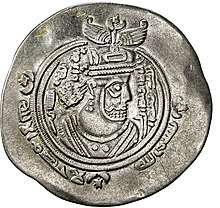Qatari ibn al-Fuja'a
Qaṭari ibn al-Fujaʾa (Arabic: قطري بن الفجاءة; died c. 698–699 CE[3][2]) was a Kharjite leader and poet.[4] Born in Al Khuwayr, he ruled over the Azariqa faction of the Kharjites for more than ten years after Najdah ibn 'Amir's death in c. 687 CE.[5] He led an uprising against the Umayyad Caliphate for more than 20 years.[6]
Qatari ibn al-Fuja'a | |
|---|---|
| Born | Qatari ibn al-Fuja'a al-Mazini al-Tamimi |
| Died | c. 698–699 CE Semnan, Persia (present-day Iran) |
| Cause of death | Killed in battle[2] |
| Years active | 687–698/699 |
| Known for | Leader of the Azariqa sub-sect |
| Title | Amir al-Mu'minin (leader of the faithful) |
| Predecessor | Najdah ibn 'Amir |
| Successor | Movement disbanded |
Ibn Khallikan, a 13th-century Muslim scholar, states that 'Qatari' is not his given name, but instead refers to the name of the region where he hailed from.[6] A member of the Banu Tamim tribe,[7] he held the title of Amir al-Mu'minin, which translates to 'leader of the faithful' and was the formal title of the Caliphs.[6] His nicknames were Na'ama (ostrich) and Abu al-Mawt (father of death).[6] It has been asserted that he was the first Khawarji leader to promote jihadism, as his poems glorified courage, death and war in the name of Allah.[6]
He minted the first known Kharijite coins, the earliest of which dated to 688 or 689.[8] It was minted in the Arab-Sasanian style. The coin bore the Pahlavi inscription "‛Abdallah Qatari, the Commander of the Faithful, who has increased the royal glory".[9]

Role in Azariqa faction
In 687, Ibn al-Fuja'a assumed leadership over the Azariqa sub-sect of the Khawarij sect of Islam during the Second Fitna. Leading his troops from Kerman, he recaptured portions of Ahvaz and marched towards Basra.[8]
Around 698 or 699, the governor of Iraq al-Hajjaj ibn Yusuf sent two of his generals, al-Muhallab ibn Abi Sufra and Sufyan ibn al-Abrad al-Kalbi, to attack Ibn al-Fuja'a and his men who were encamped in Tabaristan. After fleeing to Semnan, Ibn al-Fuja'a was confronted by Sufyan's forces. Ibn al Fuja'a's forces were defeated and he was decapitated in the encounter.[10][11] Shortly after the battle, the remnants of the Azariqa faction met their demise under the leadership of 'Abida ibn Hilal, marking the end of the Islamic sub-sect.[8]
References
- al-Aqlām. 1. Wizārat al-Thaqāfah wa-al-Irshād.
وذكر في وفيات الاعيان لابن خنكان ابو نعامة قطري بن الفجاءة واسمه جعونة ين مازن بن يزيد اين زياد ين حبتر بن مالك ين عمرو رين تهيم بن مر التميمي الثسيباني ولد في الجنوب الشرقي من قرية الخوير شمال قطر في
- Meisami, Julie Scott; Starkey, Paul (1998). Encyclopedia of Arabic Literature, Volume 2. Routledge. p. 437. ISBN 978-0415571135.
- al-Jahjah, ‘Ghuraba'’ (‘Strangers’), Sada al-Malahim 6 (Nov 2008)
- Nicholson, Reynold Alleyne (1994). A Literary History of the Arabs. Kitab Bhavan. p. 213. ISBN 978-8171511945.
- Sonbol, Amira El-Azhary (2012). Gulf Women (PDF). Bloomsbury Academic Publishing. p. 42.
- Lo, Mbaye (2009). Understanding Muslim Discourse: Language, Tradition, and the Message of Bin Laden. UPA. pp. 56, 57. ISBN 978-0761847489.
- Yosri, Mohamed (28 March 2018). "Vom Stamm der Quraisch" (in German). Qantara.de. Retrieved 9 March 2019.
- Gaiser, Adam R (2010). "What do we learn about the early Kharijites and Ibadiyya from their coins?". Journal of the American Oriental Society. The Journal of the American Oriental Society.
- "Rival caliph Qatari bin al-Fuja'a". Digitaler Ausstellungskatalog. Retrieved 10 May 2015.
- E.J.W. Gibb Memorial Series, Volume 2. p. 104. ISBN 9781286740378.
- Hottinger, Arnold. Arabs. University of California Press. p. 58. ISBN 9780520005730.
Further reading
- Yūnus, Ibrāhīm ʻAbd al-Muṭṭalib (1976). قطري بن الفجاءة : فارس من قطر (Qaṭarī ibn al-Fujāʼah : fāris min Qaṭar) (in Arabic). Cairo : al-Muʼassasah al-Afrū-ʻArabīyah.
- Qassab, Walid (1993). قطري بن الفجاءة : حياته وشعره / وليد قصاب (Qaṭarī ibn al-Fujāʾah : ḥayātuhu wa-shiʻruh) (in Arabic). al-Dawḥah : Dār al-Thaqāfah.
- Shammarī, Hazzāʻ ibn ʻĪd (2000). قطري بن الفجاءة : الفارس الشاعر (Qaṭarī ibn al-Fujāʼah : al-Fāris al-shāʻir) (in Arabic). al-Riyāḍ : Dār Ajā.
External links
- Qatari ibn al-Fuja'a on Oxford Database of Arabic Literature